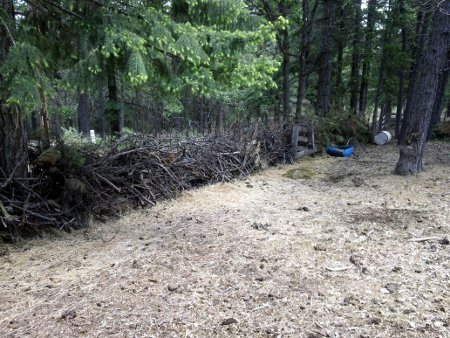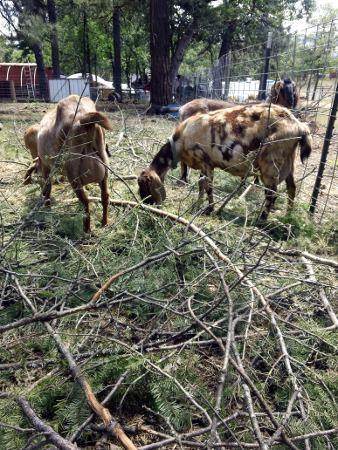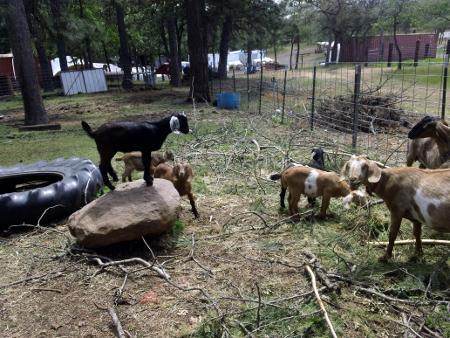Here's an article I recently posted on the Windward site. You can see the original post
here. Have any of you ever tried this technique? it's so simple, and easy, and effective!
Part of the joy I take from live here on the land, is looking at the resources that our land and living systems produce and finding ways we can create the valuable, functional goods and services we need to create a life in balance with the land.
As you all may know, I have a vision of Windward of being filled with multi-functional hedgerows that can also act as "living fences" to create pens, paddocks and garden spaces. Hedgerows have ancient applications in most parts of the world, and have been envisioned and implemented in a variety of ways throughout time and across cultures.
This spring I started work on a experiment to utilize some of the resources generated by the goats [branches and manure] to form barriers to pen in the goats, and hopefully to slowly become hugelkulture hedgerow.
As you may have read, we have been limbing and thinning parts of our forest for wild-fire prevention and overall forest health.
Since we (AKA human beings) have been preventing wildfires for almost a century now, there has been an unnatural accumulation of ladder fuel in most of the forest around here.
By taking out the low hanging, often dead, branches in an area, we take away the "ladder" with which a forest fire could climb into the tree canopy. It is most often canopy fires that kill trees and wreak havoc on the forest, so in this way we can ensure a healthful fire when the next time it rolls through this part of the plateau.
Also, since our land was logged approximately 100 years ago, some of our forest is "over stacked", with many trees of approximately the same age in unaturally high densities. This leads to direct competition between trees for light, water, and nutrients. Such competition stresses trees out, makes them far less productive, and much more susceptible to disease and natural predators like bark beetles.
One of the major and often unwieldy by-products of the forest thinning are piles and piles of branches. We worked out a long time ago that any branches that have leave/needles are fed to the sheep and goats, who love them! It is a great way to supplement their feed, and they seem to take great joy in stripping the branches of leaves, buds, lichens, mosses and sometimes of their young bark and cambium. That is one way we utilize animals to convert things we can't eat (like oak leaves) into thing that we can (like milk).
After the sheep and goat have their way with the branches, we can then find ways to use the de-foliated branches. In past years, we have used our chipper to create wood chips that we then use as feed stock for our biomass fuel project (learn more about that at www.biomass2methanol.org), or as animal bedding and mulch to build soil in our burgeoning food forests. These are great ways to use the branches, but sometimes we simply have too much biomass to work with in too short a period of time.
It are these sorts of practical challenges that I dream up solutions for in the Winter.

One of the big things that came out of that dreaming and study was a an observation of a very basic principle, that piles of sticks in the forest accumulate lots of much and decompose into nutrient rich piles of humus that many native trees and forbs find favorable to germinate in.
I had also been studying the work of
Sepp Holzer and his high alpine achievements with HugelKulture (aka large mounds of wood biomass and soil that are then planted with vegetables and trees. These types of beds utilize the water holding capacity of decayed wood, and the microclimate created by the large mounded structure and the higher soil temperatures associated with the decomposing material inside the bed.)
I had also been looking into very bare-bones agriculture in dryland areas that are more-or-less derived solely from what the land the produces. That means there are no sophisticated resources like metal fence panels, t-post, plastic what-nots, and so on. What I found was a wide range of wooden fences made out of every imaginable material, and constructed in myriad ways.
All of these things we influencing my pursuit of finding ever-more ways to meet our needs from what this land particularly provides, and in the process create low-energy input, hopefully irrigationless systems that operate passively in harmony with the flows of energy, water and nutrients of our land.
Another part of this journey was a large scale hugel kulture bed we made this spring (
learn more about this hugelkulture expriment here). --Thank you to the workshop attendees who helped us finish it off!--
That process took a lot of energy all up front in order to create the beds before the beginning of the spring growing season. While it is worth the effort to set up systems which should more-or-less go on indefinitely without much maintenance, I came out of the experience with a sense that we can do better, make more beds, faster, and have them fullfilling more functions in our whole-system besides just growing food.

What I am talking about is my ultimate goal of making a broad-acre hugel kulture hedgerow systems that can act as diverse, productive, drought-proof living fences and windbreaks for animal paddock and garden spaces.
The Dead Hedge, and how it is become a living hedge.
So this spring I took down the fencing in our goats pen and started work on creating a "dead hedge" to form the eastern fenceline. The dead hedge is essentially a very large pile of branches (about 6 feet wide at the base, and 6 feet tall) that have been woven and tied together simply by orientating the branches. Sort of like a large basket, but much rougher.
For the record, the dead hedge I constructed has proven to be a sufficient barrier to keep the goats in, and other creatures (like range cattle) out. All with just a pile of sticks!
Since the goats routinely produce manured bedding, and straw bits left over from feeding, I plan to continue to incorporate the manure into the dead hedge until the whole thing is filled up. The added manure will provide the nitrogen necessary to aid the break down of the wood, and over the next year or two the dead hedge should have nice composted soil in it sufficient to start planting.
In this way the dead hedge will slowly (and with relatively little effort) become a living hugel kulture hedgerow.
I have not yet decided upon what trees, bushes, forbs and what-not will be planted in the hedge, but I know it will be a polycultural mix of perennials. I hope to plant some foul tasting plants along the bottom and inside edge of the hedge to deter the goats from eating and killing the plants. I would like to plant small, tap-rooted suckering trees and shrubs along the heights of the hedge to provide more of a barrier, and also to provide forage and mast for the goats and other animals.
One thing I find very rewarding about this sort of system is that, with a single design element, we can cover a LOT of bases, and provide:
-fencing to keep animals either in or out
-mulch trap to keep leaves and manure from falling downhill and out of the pen
-wind break to shelter the animals and lower growing plants
-forage/mast crops that can be designed for specific animals (like pigs, goats, or chickens who all like different things)
-fodder for bees (lots of support species in ecosystems provide nectar and pollen for bees)
-visual and sound barrier that creates a certain comfortable "feel" in a space.
-habitat for all manner of insect, birds, reptiles and small mammals
To me it is a compact solution that solves most of the issues I see facing us as we move ever closer to producing our own food, fuel, fiber and forage on this classic dryland forest in the rainshadow of the Cascades.
Stay tuned for more updates on how these systems evolve!

 19
19







 One of the big things that came out of that dreaming and study was a an observation of a very basic principle, that piles of sticks in the forest accumulate lots of much and decompose into nutrient rich piles of humus that many native trees and forbs find favorable to germinate in.
One of the big things that came out of that dreaming and study was a an observation of a very basic principle, that piles of sticks in the forest accumulate lots of much and decompose into nutrient rich piles of humus that many native trees and forbs find favorable to germinate in.







 18
18





 1
1




 1
1








 .
.
 1
1




 1
1




 4
4





 4
4




![Filename: deadhedge1.jpg
Description: deade hedge after several years [Thumbnail for deadhedge1.jpg]](/t/25625/a/37951/deadhedge1.jpg)




 1
1




 1
1




 1
1




 10
10




 5
5




 3
3




 1
1












